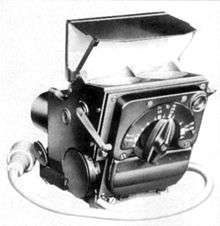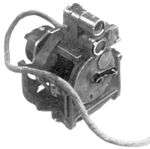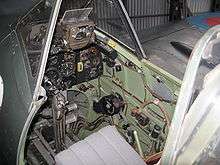Gyro gunsight

A gyro gunsight (G.G.S.) is a modification of the non-magnifying reflector sight in which target lead (the amount of aim-off in front of a moving target) and bullet drop are allowed for automatically, the sight incorporating a gyroscopic mechanism that computes the necessary deflections required to ensure a hit on the target. The sight was developed just before the Second World War for aircraft use during aerial combat.
The sights usually contained more than one reticle to assist in proper aiming point: a fixed one (signifying the direction the guns are pointing), a moving one showing the corrected aiming point, and a reticle to match to a target plane's known wingspan (to adjust the sight for the target's distance).
History

Gyro gunsights were (for the most part) modifications of the reflector gunsight to aid pilots in hitting targets (other aircraft) that were turning rapidly in front of them. The reflector sight (first used on German fighters in 1918[1] and widely adopted on all kinds of fighter and bomber aircraft in the 1930s) was an optical device consisting of a 45 degree angle glass beam splitter that sat in front of the pilot and projected an illuminated image of an aiming reticle that appeared to sit out in front of the pilot's field of view at infinity and was perfectly aligned with the plane's guns ("boresighted" with the guns). The optical nature of the reflector sight meant it was possible to feed other information into field of view, such as modifications of the aiming point due to deflection determined by input from a gyroscope.[2]
It is important to note that the information presented to the pilot was of his own aircraft, that is the deflection/lead calculated was based on his own bank-level, rate of turn, airspeed etc. The assumption was that the flightpath was following the flightpath of the target aircraft, as in a dogfight, therefore the input data was close enough.
British developments
After tests with two experimental gyro gunsights which had begun in 1939, the first production gyro gunsight was the British Mark I Gyro Sight (left), developed at Farnborough in 1941. To save time in development the sight was based on the already existing type G prismatic sight, basically a telescopic gun sight folded into a shorter length by a series of prisms.[3] Prototypes were tested in a Supermarine Spitfire and the turret of a Boulton Paul Defiant in the early part of that year. With the successful conclusion of these tests the sight was put into production by Ferranti, the first limited-production versions being available by the spring of 1941, with the sights being first used operationally against Luftwaffe raids on Britain in July the same year. The Mark I sight had a number of drawbacks however, including a limited field of view, erratic behavior of the reticle, and requiring the pilot/gunner to put their eye up against an eyepiece during violent maneuvers.
Production of the Mark I was postponed and work started on an improved sight. Changes involved incorporating the gyro adjusted reticle into a more standard reflector sight system. This new sight became the Mark II Gyro Sight, which was first tested in late 1943 with production examples becoming available later in the same year. In the Mark II the pilot had to set the wingspan of the target, and use a throttle mounted control to keep the target centered.[4]

The Mark II was also subsequently produced in the US by Sperry as the K-14 (USAAF) and Mk18 (Navy)
The radar-aimed AGLT Village Inn tail turret incorporated a Mark II Gyro Sight and this turret was fitted to some Lancaster bombers towards the end of World War II.
German developments
Although since 1935 the relevant German companies offered the Reich Air Ministry (RLM) a new type of gyro-stabilized sight, the well-proven REVI (Reflexvisier, or reflector sight) remained in service for combat aircraft. The gyro-stabilized sights received an additional designation of EZ (Einheitszielvorrichtung, or Target Predictor Units), such as EZ/REVI-6a. The development of the EZ 40 gyro sight began in 1935 at the Carl Zeiss and Askania companies, but was of low priority. Not until the beginning of 1942, when a US P-47 Thunderbolt fighter equipped with a gyro-stabilised sight was captured, did the RLM speed up research. In the summer of 1941, the EZ 40, for which both the Carl Zeiss and Askania companies were submitting their developments, was rejected. Tested in a Bf 109 F, Askania's EZ 40 produced 50 to 100% higher hit probability compared to the then standard sight, the REVI C12c.[5] In the summer of 1943 an example of the EZ 41 developed by the Zeiss company was tested, but was refused because of too many faults. In the summer 1942, the Askania company began work on the EZ 42, a gunsight which could be adjusted for the target's wingspan (in order to estimate distance to the target). Three examples of the first series of 33 pieces were delivered in July 1944. These were followed by further 770 units, the last being delivered by the beginning of March 1945. Each unit took 130 labour hours to produce. The EZ 42 was made up by two major parts, and lead computation was provided by two gyroscopes. The system, weighing 13.6 kg (30 lb) complete, of which the reflector sight was 3.2 kg, was ordered into mass production at the Steinheil company in Munich. Approximately 200 of the sights were installed into Fw 190 and Me 262 fighters for field testing. The pilots reported that attacks from 20 degrees deflection were possible, and that although the maximum range of the EZ 42 was stated as approximately 1,000 meters, several enemy aircraft were shot down from a combat distance of 1,500 meters.[6]
The EZ 42 was compared with the Allied G.G.S. captured from in a P-47 Thunderbolt in September 1944 in Germany. Both sights were tested in the same Fw 190, and by the same pilot. The conclusion was critical of the moving graticule of the G.G.S., which could be obscured by the target. Compared to the EZ 42, the Allied sight's prediction angle was found on average to be 20% less accurate, and vary by 1% per degree. Tracking accuracy with the G.G.S. measured as the mean error of the best 50% of pictures was 20% worse than with the EZ 42.[7]
Usage (Mark II Gyro Sight)
- Avro Lincoln
- Blackburn Firebrand
- Chance Vought F-4U Corsair
- de Havilland Hornet & Sea Hornet
- de Havilland Mosquito
- de Havilland Vampire
- de Havilland Venom & Sea Venom
- Fairey Firefly
- Gloster Meteor
- Hawker Hurricane
- Hawker Tempest
- Hawker Typhoon
- Hawker Fury & Sea Fury
- Hawker Sea Hawk
- Lockheed P-80 Shooting Star
- North American P-51 Mustang
- North American F-86 Sabre
- Republic P-47 Thunderbolt
- Republic F-84 Thunderjet
- Supermarine Attacker
- Supermarine Seafang
- Supermarine Spiteful
- Supermarine Spitfire
See also
- Head-up display - the further evolution of the gyro reflector gunsight
References
- ↑ British Aircraft Armament Vol.2: Guns and /Gunsights", by R Wallace Clarke
- ↑ [Lon O. Nordeen, Air warfare in the missile age, page 265]
- ↑ Axis History Forum - RAF Fixed and Free-mounted Reflector Gunsights
- ↑ View from the line
- ↑ Hahn, p. 147.
- ↑ Hahn, p. 148.
- ↑ Hahn, p. 150.
Bibliography
- Hahn, Fritz. Deutsche Geheimwaffen 1939-1945. Flugzeugbewaffungen. Heidenheim: Erich Hoffmann Verlag, 1963.
External links
| Wikimedia Commons has media related to Gyro gunsights. |
- A more complete explanation of the gyro gunsight
- RAF, Luftwaffe and USAAF gunsights of WW2
- www.cocpitinstrumente.de - EZ 40 Kreiselvisier (in German)